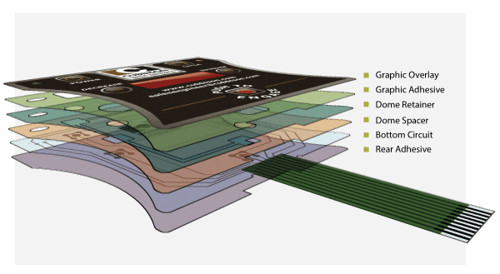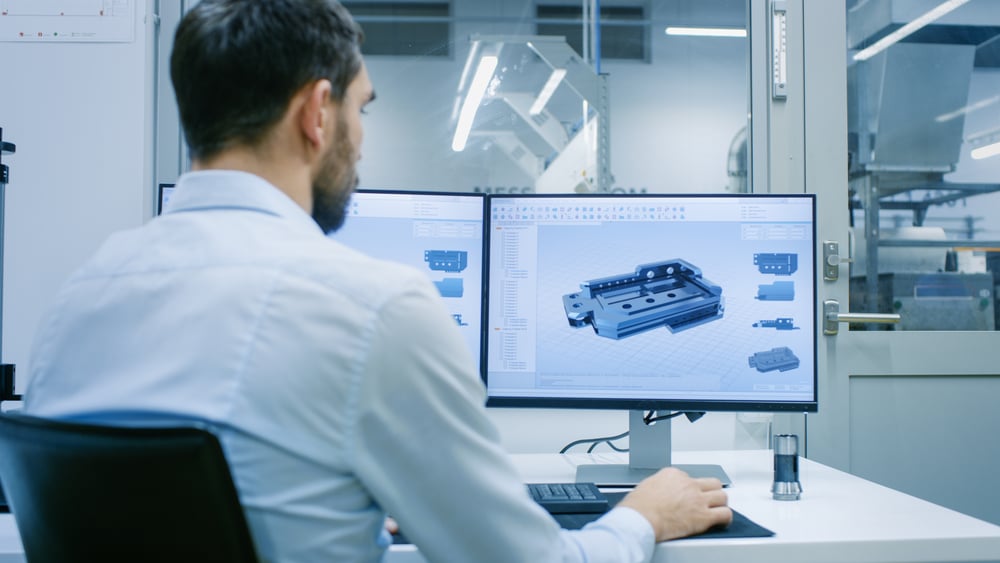Today's marketplace demands fast, accurate, and reliable human-machine interface solutions. Before you develop your application, consider the expectations of your clients: ease of use, satisfactory tactile response, and rapid functionality.
To ensure a successful application, it is important to focus carefully on the design of your membrane switch. Our design engineers are available to help you identify and achieve criteria specific to your needs.
The following information outlines membrane switch components and related design considerations. By walking through the design factors related to each membrane switch component, you will be able to maximize the quality, reliability, and efficiency of your membrane switch.
Membrane switches are characterized as tactile and non-tactile. Both can be constructed with or without a graphic overlay. The variation comes in the presence or lack of a dome.
Tactile switches are designed to include a metal dome or poly dome. The dome allows operators to experience feedback in the form of a physical “snap,” which confirms for the user that the button has been depressed.
Non-tactile switches do not have a metal dome or poly dome; therefore, non-tactile switches do not provide any type of physical feedback when the push button has been depressed.
A typical membrane switch construction consists of the following layers:

Graphic Overlay
Graphic Adhesive
Dome Retainer (top circuit for matrix circuit configuration)
Dome Spacer (used with metal domes)
Bottom Circuit
Rear Adhesive
To discuss design constructions that will best suit your needs, email salesengineer@cubbison.com.
Graphic Overlay
Circuitry configuration uses either a common bus, a matrix, or a combination of the two.
The connection from the membrane switch to the printed circuit board (PCB) can be made one of three ways.
The tail termination pitch can be 2.54mm, 1.27mm, 1.00mm, or 0.5mm. Metal tines are used for electrical connections.
Prepress
Our full-service art department can provide membrane switch design services if you do not have existing artwork. One of our expert design engineers will work with you to customize the design and construction of a membrane switch that is ideal for your application.
We can also help you determine the printing option that will be most effective for your intended printed electronics application: screen printing, digital printing, or a combination of screen and digital printing.
Other requirements:
Acceptable software files:
We offer a variety of hard-coated, textured-polyester and polycarbonate films. These substrates are designed specifically for the graphic overlay film on membrane switches. Finish options range from high-gloss to velvet-matte. All film options are solvent and resistant to chemicals and scratches. They can also be screen printed onto a second surface.
Polyester is the most popular film choice because of its robust nature and superior chemical resistance. Polyester also supports up to 5 million actuations over its lifetime, as opposed to polycarbonate, which is rated for up to 100,000 actuations.
For additional information, please email salesengineer@cubbison.com.
The Pantone Matching System (www.pantone.com) is the most popular color matching system for graphic arts applications. With our digital presses, we can match Pantone, custom, and transparent colors.
With our state-of-the-art X-rite Ci7600 spectrophotometer, we can successfully match printed overlay colors to surrounding components, an otherwise challenging task. Once we identify a control color for matching, we can achieve a color match under 1.0 delta in the CIE Lab color space. We are also able to conduct transmission and density readings.
We can produce pillow (pad) or rim (perimeter) key tactile designs into polyester or polycarbonate overlays. The overlay embossing process requires a male/female die set that can be manufactured with sophisticated tolerances to allow for material flow. Our design staff can precision-calculate a die for your particular membrane switch application.
Display windows are typically transparent and can be either clear or color-tinted. LED windows can be translucent or transparent (with or without color).
A transparent color is optically clear and useful in filtering backlight displays. It also reduces a display's "blooming effect."
A translucent color is typically used to diffuse an indicator light or to backlight printed graphics, such as a backlit instrument cluster.
We offer hard-coat films that are ideal for membrane switch overlay applications. These hard-coat films are polycarbonate and polyester substrates that have been treated so that their surfaces can be selectively textured, embossed, or printed with UV inks. Finish options range from glossy clear to textured matte black. A selection of hard-coat films are also available for displays.
Hard-coat films are valuable because of their resistance to scratches, food stains, and the detrimental impact of household cleaners and aggressive chemicals. For medical equipment and other special applications, hard-coat films can be embossed or otherwise thermoformed without sacrificing performance characteristics.
We can print state-of-the-art UV inks specifically designed to provide decorative texture on first-surface polyester or polycarbonate membrane switch overlays. UV inks create extremely durable textures that will withstand marring and other challenging environmental factors.
Texture coats range from very fine to coarse, and if you have an existing texture, we can customize a match.
Circuitry design relies on a common bus or matrix configuration, or a combination of the two. The connection from the membrane switch to the PCB is made via a cable interconnect, or “tail” that is terminated with bare contacts, a plastic connector housing, or solder tabs.
The tail termination pitch can be 2.54mm, 1.27mm, 1.00mm, or 0.5mm. The tail can exit from either an edge or inset location of the part, but not from the button area.
We offer a variety of heat-stabilized polyester films that meet high-stability specifications. These films are designed to be screen printed with conductive silver and/or carbon inks, graphite inks, and dielectric inks.
ESD, RFI/EMI, the most common types of shielding, are printed using carbon ink or silver ink, or by using solid aluminum foil.
Printing with carbon ink is the most cost-effective is the least expensive shielding option. Aluminum foil, on the other hand, has advantages if a printed top circuit is not specified.
A shield can be terminated by either a conductive trace routed to the connector or with a ground strap cut from the polyester material. Our design engineers will help you determine your best shielding solution.
Metal dome design options for tactile switches include 4-legged and oblong domes.
Typical characteristics of 4-legged domes:
Typical characteristics of oblong domes:
When a switch is deflected, it must be designed to include a small track that is connected to all of the switch keys. This track allows air to be displaced. When venting is done internally, the switch remains sealed. For this reason, external venting is not recommended.
We offer aluminum, polycarbonate, and acrylic material options for a rigid sub-panel.
It is usually advisable for the sub-panel to be slightly smaller than the membrane switch. Conversely, the holes and cutouts should be slightly larger than those on the membrane switch, in order to conceal the sub-panel.
If needed, we can laser fabricate a sub-panel to your specifications.
The NEMA 4 gasket feature increases the protection of a membrane switch against environmental factors, such as dirt and moisture.
Mechanical:
Electrical:
Configuration:
Environmental:
Voltage: Voltage is the difference in electrical potential between two points in an electrical or electronic circuit, expressed in volts; Voltage measures the potential energy of an electric field to cause an electric current in an electrical conductor. It is the measure of pressure under which electricity flows.
Dielectric: Dielectric refers to a non-conducting substance, i.e. an insulator. Although "dielectric" and "insulator" are generally considered synonymous, the term "dielectric" is more often used when considering the effect of alternating electric fields on the substance, while "insulator" is more often used when the material is being used to withstand a high electric field.
Optical fiber: Optical fiber is a thin glass strand designed for light transmission. A single hair-thin, optical fiber is capable of transmitting trillions of bits per second.
ESD (electrostatic discharge): ESD is the rapid, sudden transfer of electrostatic charge between two electrically charged surfaces.
RFI (radio frequency interference): RFI is interference or “noise” that adversely affects the operation of an electrical circuit. RFI is limited to the radio frequency spectrum.
EMI (electromagnetic interference): EMI is interference or “noise” that adversely affects the operation of an electrical circuit. EMI encompasses all frequencies of electrical noise.
Light-guide film (LGF): LGF is a patterned film that uses LED’s to guide light along the patterned surface.
Embossing: Embossing adds a raised surface to a graphic overlay. It is typically applied to a pushbutton. Embossing is also used for a poly-dome layer.
The Cubbison Company can support the design and manufacturing of other human-machine interface products.
Sensors monitor, quantify, and self-correct a multitude of biological, mechanical, and environmental factors. They are an important contributor to the Internet of Things, because they provide a real-time exchange of information between people and devices. Sensors also contribute to life-changing solutions, especially in the medical device industry. Read more about sensors.
Touchscreens display points of human-machine interaction resulting from touch. The Cubbison Company manufactures projective capacitive and resistive touchscreens. Read more about touchscreens.
Intelligent Touch Sensors respond to the physical touch or proximity of a human operator, while eliminating inadvertent actuations. Read more about HSS™.
Contact us to discuss your user-interface project.
 Rapid Prototyping
Rapid PrototypingAchieving optimum functionality of your user-face assembly requires thoughtful design. You can rely on The Cubbison Company's design and engineering experts to guide you from the idea phase through a working prototype and on to full production.
Read how The Cubbison Company's Rapid Prototype Program can save you time and money.